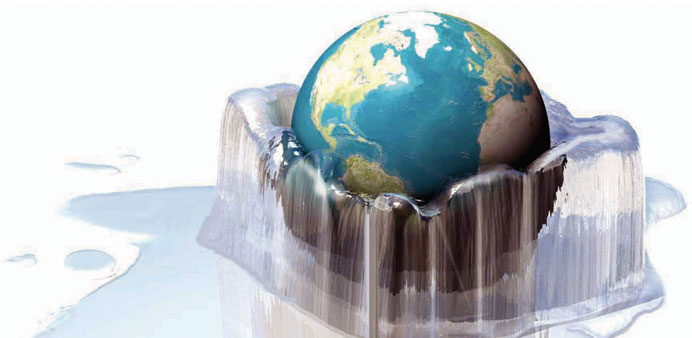By Abdullah Al Mamoon/Doha
Climate change has globally impacted and altered the hydrologic cycle in our environment. The Intergovernmental Panel on Climate Change (IPCC) predicts that changes in temperatures, sea levels, and weather patterns are all likely to deteriorate in the future depending on the level of future developments.
Sea levels are rising due to thermal expansion of water as a result of global warming and melting of land-based ice such as Greenland and Antarctic ice caps.
Current scientific research suggests that if the Greenland ice sheet were to melt away to nothing, sea levels would rise to approximately 6m. The alarming fact is that a loss of just 1% of the Greenland ice cap would result in a sea level rise of 60mm.
The ocean absorbs nearly a third of CO2 released by humans into the atmosphere. As the ocean is gradually warming up along with the planet, the ocean’s carbon absorption capacity is also decreasing, since warmer water cannot hold as much CO2.
The worst things is that even if we succeed in totally stopping greenhouse gas emissions into the atmosphere, the oceans would continue to rise for several centuries as a result of these emissions in the past years.
Due to high emissions, the IPCC now predicts global sea levels will rise by 52-98cm by 2100. Consequently, this would threaten the survival of coastal cities, entire island nations and greatly increase risk of flooding.
According to the IPCC, the global mean temperature has risen by nearly 1 degree Celsius in the last 100 years. Each of the last three decades has been successively warmer at the Earth’s surface than any preceding decade since 1850.
Most scientists agree that the global temperature must be limited to less than 2 degrees Celsius in order to avoid catastrophic climate change. Given the rate at which the greenhouse gases are being released into the atmosphere, the World Bank has warned that the world is heading towards the course of a 4 degrees Celsius temperature rise which will definitely make earth a much less livable place for us.
Qatar and other countries in the Gulf region face serious challenges from climate change of mainly sea level and temperature rise. A metre rise in sea levels would directly affect 3.2% of the Gulf region’s population, with possible inundation of coastal towns, ports and increasing salinity of soil and fresh water reserves in the aquifers.
Sea level and temperature rise will impact various infrastructures in Qatar; including buildings in coastal settlements, electricity distribution and transmission networks, water supply infrastructure, variety of onshore industries (petrochemical, power, desalination, waste water treatment and fertiliser plants etc.), port infrastructure and operations.
Also, since a vast majority of nuclear installations are built by the sea in order to use seawater for cooling, rising sea levels may potentially cause a threat.
Likely impacts on buildings in coastal settlements would include potential failure of facilities; such as desalination and sewerage treatment plants from inundation and flooding, reduced life expectancy of buildings and increased operational expenditure.
Coastal regions would also likely to have a loss in property and real estate, damage to recreational infrastructure and coastal infrastructure used for transportation. Furthermore, electricity transmission and distribution (T&D) networks would be overloaded due to the growing demand from higher temperatures and increase in air conditioner usage.
This may result in accelerated deterioration of assets and potential blackouts due to demand exceeding supply.
Possible damage to T&D infrastructure in low-lying areas due to inundation, such as sub-stations, may result in reduced network capacity, require relocation and potentially reconstruction of infrastructure assets.
A sea level rise is likely to increase the risk of salination of surface and groundwater sources in coastal areas that may be part of the water supply system.
Although climate change study predicts much higher intensity towards the end of the century, the impact on the water supply infrastructures in Qatar is anticipated to be not as extreme since the state is less reliant on rainfall and more focused on alternative water supply (i.e. desalination, recycled water).
Port infrastructure and operations will be affected due to change in sea level rise, leading to increased port downtime, reduction in port through-put and decreased productivity. There will also be increased maintenance, repair and replacement of port infrastructure due to degradation of port assets and corrosion.
Climate change will have wide-ranging effects on the infrastructures in Qatar that is likely to require costly investment in infrastructure adaptations to the changing climate. A multi-faceted approach involving a range of skills from planning, design, construction and management will be required to best manage this issue.
However, to provide certainty that Qatar’s infrastructures can be properly managed, there needs to be more understanding on what infrastructure is vulnerable to the impact of climate change, particularly the predicted rise in sea levels and temperature.
- Abdullah Al Mamoon, a Chartered Professional Engineer (CPEng), is a water and climate change expert based in Qatar.

